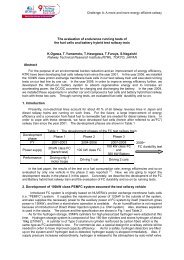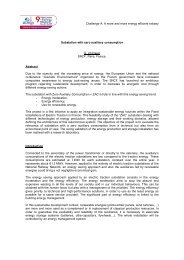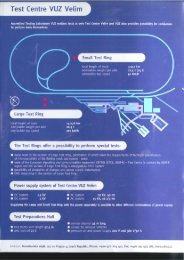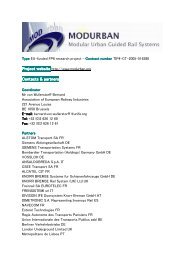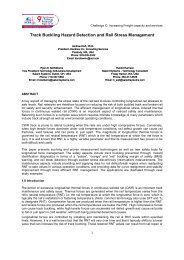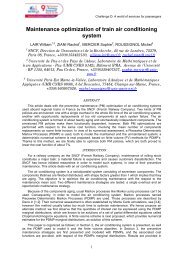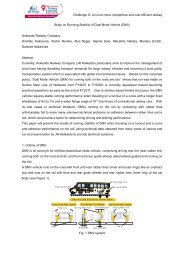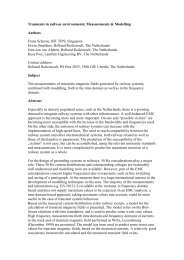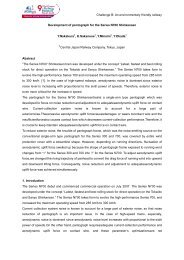Fatigue analysis of catenary contact wires for high speed trains
Fatigue analysis of catenary contact wires for high speed trains
Fatigue analysis of catenary contact wires for high speed trains
Create successful ePaper yourself
Turn your PDF publications into a flip-book with our unique Google optimized e-Paper software.
Challenge E: Bringing the territories closer together at <strong>high</strong>er <strong>speed</strong>s<br />
C<br />
B<br />
z<br />
D<br />
y<br />
Wear<br />
A<br />
E<br />
Figure 13. Virtual <strong>contact</strong> wire section.<br />
The numerical result, illustrated in Figure 14, is different from measurements <strong>for</strong> waves which precede<br />
and follow the pantograph passage.<br />
It can be explained by differences <strong>of</strong> French and Japanese catenaries and pantographs or by different<br />
damping ratio in <strong>catenary</strong> or by differences <strong>of</strong> frequency bandpass between measurements and<br />
s<strong>of</strong>tware [8].<br />
Bending strain amplitude (x10 -6 )<br />
600<br />
400<br />
200<br />
0<br />
-200<br />
Time<br />
Figure 14. Contact wire bending stress amplitude computed with OSCAR © .<br />
Nevertheless, the maximum and minimum bending strain amplitudes due to peak are similar and thus<br />
these results are good enough to make a preliminary fatigue <strong>analysis</strong>.<br />
A criterion based on the Goodman's theory [9] is used, assuming an uniaxial loading. Although this<br />
assumption is not verified, it is applied in order to identify the most critical zone in the <strong>catenary</strong> as a<br />
preliminary study.<br />
To apply this criterion, the maximum value and the minimum value <strong>of</strong> the longitudinal stress is<br />
calculated <strong>for</strong> each node <strong>of</strong> the mesh, using respectively<br />
max<br />
x,<br />
y,<br />
z,<br />
t min x,<br />
y,<br />
z,<br />
t .<br />
and <br />
max<br />
t<br />
xx<br />
Secondly, the criterion is applied and the point P(x,y,z), corresponding to the maximum value <strong>of</strong><br />
a <br />
0.3 max<br />
max<br />
min<br />
is identified, with <br />
a<br />
x, y,<br />
z<br />
<br />
.<br />
2 3<br />
2<br />
The criterion can be expressed in a better known <strong>for</strong>m as:<br />
b<br />
a<br />
a m<br />
where a is the tensile strength and b is the fatigue limit.<br />
The result <strong>of</strong> this study, applied on French <strong>catenary</strong> and shown in Figure 15, illustrates that the<br />
<strong>high</strong>est values <strong>of</strong> the criterion are closed to support represented by vertical dotted lines on Figure 15.<br />
min<br />
t<br />
xx



